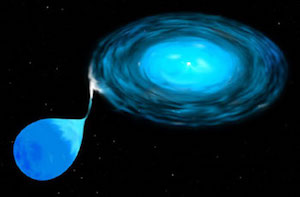Fool-Proofing Galactic "Candles"
The "standard candle" used for measuring the distance to other galaxies just got a much-needed tune-up.

Image credit: STScI
Artist's concept of a white dwarf in a binary system with another star. The white dwarf is pulling material from the companion, and may eventually gain enough mass to become a Type 1a supernova.
Some bright supernovae are created by the deaths of white dwarf stars in binary systems. These are Type Ia supernovae, and they have been used as a standard candle for many years. Wherever they occurred, they were believed to have roughly the same actual brightness. For this reason, scientists used them to measure the distance to the galaxies they are located in. Imagine that an astronomer observes two Type 1a supernovae, one that is dimmer than the other. Because all of the Type 1a supernovae have the same actual brightness, the dim one only appears dimmer because it was further away. Recent research has revealed a way to greatly improve the accuracy of these calculations.
In the 1940s, astronomers realized supernovae came in two forms: some (Type I) did not contain hydrogen, while others (Type II) did contain hydrogen. The lack of hydrogen means that the star has used up the basic fuel that drives nuclear reactions in stars. Type II supernovae were found to result from the collapse of a single, massive star. In the 1980s, however, it became clear that some Type I supernovae also come from the collapse of massive stars. The remaining Type I supernovae, now called Type Ia, were found instead to result from the collapse of a white dwarf star in a binary star system.
In a binary system, a white dwarf can gravitationally pull mass from its companion star. If enough mass is pulled from the companion, the white dwarf reaches a critical mass and gravity will crush it. The white dwarf collapses and explodes as a Type Ia supernova.
Since all Type Ia supernovae are created by the explosion of a white dwarf star as it exceeds the critical mass, astronomers believed they should all have the same actual brightness and should be useful as a measuring stick to distant galaxies. Type Ia supernovae may also be visible at distances greater than the Cepheid variable stars. Cepheids were identified as standard candles in 1912 by Henrietta Leavitt.
But it turns out that not all Type Ia supernovae are equal, either. Scientists have discovered that they show a pattern of brightening and fading over several days and that the pattern varies a great deal. Astronomer Mark Phillips at the Cerro Tololo Interamerican Observatory in Chile found that some brighter Type Ia supernovae fade more slowly over the first 15 days than do dimmer ones.
By sorting the dim, fast-fading supernovae from the bright, slow-fading ones, Phillips arrived at a luminosity-decline relation. By using this relation, astronomers can adjust the distance measure, and increase the accuracy of the distance measurements. •



